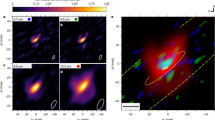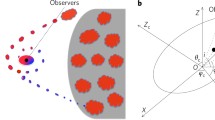Abstract
Active galactic nuclei (AGNs) display many energetic phenomena—broad emission lines, X-rays, relativistic jets, radio lobes—originating from matter falling onto a supermassive black hole. It is widely accepted that orientation effects play a major role in explaining the observational appearance of AGNs. Seen from certain directions, circum-nuclear dust clouds would block our view of the central powerhouse1,2. Indirect evidence suggests that the dust clouds form a parsec-sized torus-shaped distribution. This explanation, however, remains unproved, as even the largest telescopes have not been able to resolve the dust structures. Here we report interferometric mid-infrared observations that spatially resolve these structures in the galaxy NGC 1068. The observations reveal warm (320 K) dust in a structure 2.1 parsec thick and 3.4 parsec in diameter, surrounding a smaller hot structure. As such a configuration of dust clouds would collapse in a time much shorter than the active phase of the AGN3, this observation requires a continual input of kinetic energy to the cloud system from a source coexistent with the AGN.


Similar content being viewed by others
References
Antonucci, R. Unified models for active nuclei and quasars. Annu. Rev. Astron. Astrophys. 31, 473–521 (1993)
Urry, C. M. & Padovani, P. Unified schemes for radio-loud active galactic nuclei. Publ. Astron. Soc. Pacif. 107, 803–845 (1995)
Krolik, J. H. & Begelman, M. C. Molecular tori in Seyfert galaxies: Feeding the monster and hiding it. Astrophys. J. 329, 702–711 (1998)
Antonucci, R. J. & Miller, J. S. Spectropolarimetry and the nature of NGC 1068. Astrophys. J. 297, 621–632 (1985)
Lumsden, S. L. et al. Near- and mid-infrared imaging polarimetry of NGC 1068. Mon. Not. R. Astron. Soc. 303, 209–220 (1999)
Leinert, C. et al. Ten-micron instrument MIDI: getting ready for observations on the VLTI. Proc. SPIE 4838, 893–904 (2003)
Glindermann, A. et al. The VLTI—A Status Report. Proc. SPIE 4838, 89–100 (2003)
Muxlow, T. W. B., Pedlar, A., Holloway, A. J., Gallimore, J. F. & Antonucci, R. R. J. The compact radio nucleus of the Seyfert galaxy NGC 1068. Mon. Not. R. Astron. Soc. 278, 854–860 (1996)
Bock, J. J. et al. High spatial resolution imaging of NGC 1068 in the mid-infrared. Astron. J. 190, 2904–2919 (2000)
Lutz, D. et al. ISO-SWS spectroscopy of NGC 1068. Astrophys. J. 536, 697–709 (2000)
Kemper, F., Vriend, W. J. & Tielens, A. G. G. M. ISO spectra of Sgr A. Astrophys. J. (submitted)
Speck, A. K., Barlow, J. J., Sylvester, F. J. & Hofmeister, A. M. Dust features in the 10 micron infrared spectra of oxygen-rich evolved stars. Astron. Astrophys. Suppl. 146, 437–464 (2000)
Maiolino, R. et al. Dust in active nuclei. I. Evidence for anomalous properties. Astron. Astrophys. 365, 28–36 (2001)
Pier, E. A. & Krolik, J. H. Infrared spectra of obscuring dust tori around active galactic nuclei. Astrophys. J. 401, 99–109 (1992)
Efstathiou, A., Hough, J. H. & Young, S. A model for the infrared continuum spectrum of NGC 1068. Mon. Not. R. Astron. Soc. 277, 1134–1144 (1995)
Granato, G. L., Danese, L. & Franceschini, A. Thick tori around active galactic nuclei: the case for extended tori and consequences for their X-ray and infrared emission. Astrophys. J. 486, 147–159 (1997)
Schartmann, M. Dust Tori in Active Galactic Nuclei. Thesis, Univ. Heidelberg (2003)
Crenshaw, D. M. & Kraemer, S. B. Resolved spectroscopy of the narrow-line region in NGC 1068: Kinematics of the ionized gas. Astrophys. J. 532, L101–L104 (2000)
Nenkova, M., Ivezić, Z. & Elitzur, M. Dust emission from active galactic nuclei. Astrophys. J. 570, L9–L12 (2002)
Bruhweiler, F. C., Miskey, C. L., Smith, A. M., Landsman, W. & Malumuth, E. Ionization, extinction and spiral structure in the inner disk of NGC 1068. Astrophys. J. 546, 866–876 (2001)
Bland-Hawthorn, J. et al. The Ringberg standards for NGC 1068. Astrophys. Space Sci. 248, 9–19 (1997)
Acknowledgements
This Letter is based on observations carried out at the European Southern Observatory, Paranal, Chile, in the framework of the VLTI science demonstration program. MIDI could not have been built without contributions from many people, including E. J. Bakker, P. Ballester, S. Beckwith, P. Biereichel, A. Böhm, W. D. Cotton, S. Damstra, A. Glindemann, B. Grimm, J. de Jong, N. Haddad, H. Hanenburg, T. Henning, N. Housen, S. Hippler, W. Laun, S. Ligori, R. Lenzen, B. Lopez, O. von der Lühe, R. J. Mathar, J. Meisner, S. Morel, W. Morr, U. Neumann, R.-R. Rohloff, P. Schuller, N. Salm, C. Storz, A. Wallander and K. Wagner. We thank ESO staff at Garching, Santiago de Chile, and Cerro Paranal (Chile), for operating MIDI.
Author information
Authors and Affiliations
Corresponding author
Ethics declarations
Competing interests
The authors declare that they have no competing financial interests.
Rights and permissions
About this article
Cite this article
Jaffe, W., Meisenheimer, K., Röttgering, H. et al. The central dusty torus in the active nucleus of NGC 1068. Nature 429, 47–49 (2004). https://doi.org/10.1038/nature02531
Received:
Accepted:
Issue Date:
DOI: https://doi.org/10.1038/nature02531
- Springer Nature Limited
This article is cited by
-
Thermal imaging of dust hiding the black hole in NGC 1068
Nature (2022)
-
The high energy Universe at ultra-high resolution: the power and promise of X-ray interferometry
Experimental Astronomy (2021)
-
New active galactic nuclei science cases with interferometry
Experimental Astronomy (2018)
-
A recent history of science cases for optical interferometry
Experimental Astronomy (2018)
-
Tidally disrupted dusty clumps as the origin of broad emission lines in active galactic nuclei
Nature Astronomy (2017)





